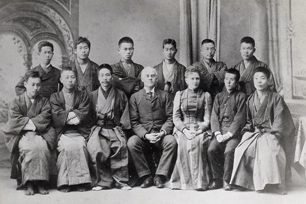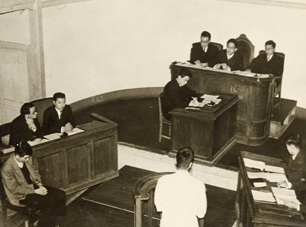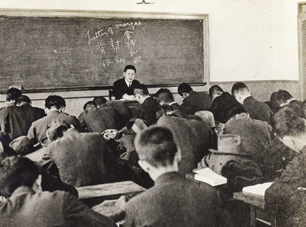125 years since the Establishment of the First Keio University Departments (1)—History of the Faculties of Letters and Law
In 1890, Keio University established the first university departments of literature, law, and economics, which were the precursors of the current Faculty of Letters, Faculty of Law, and Faculty of Economics/Faculty of Business and Commerce, respectively. The first part of this feature article will trace the history of the Faculty of Letters and the Faculty of Law and how they have changed since their establishment 125 years ago.
Faculty of Letters
Ogai Mori and Kafu Nagai Teach at Keio
The Founding of Mita Bungaku in 1910

Since its founding, Keio University has placed strong emphasis on English education. In 1890, on the occasion of the establishment of the first university departments in literature, law, and economics, Harvard’s then president Charles Elliot was called on for assistance, and he nominated William S. Liscomb (a graduate of Brown University) to head the department of literature. Liscomb’s successor was Arthur Lloyd from England followed by Thomas Sergeant Perry, the grandson of the brother of Commodore Matthew Perry who commanded the “Black Ships” that had arrived in Japan at the end of the Edo period.
At the time, the department was not divided into specialized majors; there was one three-year program offering classes on various subjects including rhetoric, history of British and American literature, Chinese literature, psychology, and ethics, and French and German language classes were optional. Ogai Mori (Rintaro Mori) also gave a course on aesthetics from 1892 to1899.
Twenty students were admitted to the department in the inaugural year, and with some students withdrawing during their studies, the remaining twelve became the first graduates. In the following years the number of graduates dropped to single digits, and in May 1901, the department stopped operating as there were no student enrollments. However in 1903, with the enforcement of the Professional College Order , a two-year preparatory course and a three-year regular course were set up, and the literature department reopened the next year.

With reforms in 1910, the department was divided into the three disciplines of literature, philosophy, and history. Keio appointed Teiichi Kawai—one of the first graduates of the department of literature, who also studied at Friedrich Schiller University Jena and Universität Leipzig in Germany—as head of the literature department (later becoming the dean); Ogai Mori and Bin Ueda as advisers; and Sokichi Nagai (Kafu Nagai) as faculty. The same year saw the launch of Mita Bungaku edited by Kafu, exerting a huge influence on the literary world.
In 1918, under the promulgation of the University Order, approval was given for the establishment of other universities in addition to the five Imperial Universities that had existed up to this time. In 1920, Keio became a private comprehensive university with four faculties (Letters, Economics, Law, and Medicine) in addition to the premedical courses that had already been established at Keio’s School of Medicine in 1917.
A library school was established at the Faculty of Letters in 1951, Japan’s first school in librarianship at the higher education level. It was part of the postwar reforms enacted by the US occupying forces, and Keio University was selected among other Japanese universities as the location for the school. Robert L. Gitler, who was Director of the University of Washington School of Librarianship at the time, chose Keio because he had been so moved by Yukichi Fukuzawa after reading The Autobiography of Yukichi Fukuzawa. The school was later named the School of Library and Information Science (becoming one of the majors offered by the Faculty of Letters).
As of 2000, the Faculty of Letters is comprised of the Department of Humanities and Social Science in which there are 17 majors.
Faculty of Law
Torajiro Kanbe of the Inaugural Class lays the Foundation for the Mita Law Tradition

In the same manner Liscomb was appointed head of the literature department in 1890, the first head of the law department was John H. Wigmore, a graduate of Harvard University. At the beginning, education was centered around British law, but with the promulgation of the Constitution of the Empire of Japan (1889), a legal system based largely on the German model was being established, and legal education gradually became more oriented toward domestic civil law systems based on statutory laws.
Torajiro Kanbe, who was among the first graduates of the inaugural class, studied abroad at Humboldt-Universität zu Berlin and Martin Luther University Halle-Wittenberg in Germany, earning a doctorate in law, and upon returning to Japan, became full-time faculty and dean of the law department at Keio. This was big news in legal circles, so much so that Hideo Hatoyama of the Tokyo Imperial University remarked, “the center of Japanese legal science has now shifted from Hongo [where Tokyo Imperial University was located] to Mita.” Torajiro Kanbe played an integral part in building the foundation of the Mita law tradition.


In 1920, when Keio became a comprehensive university, the department of law merged with the department of political science, which was founded in 1898, and became the present Department of Law and Department of Political Science within the Faculty of Law.
After graduating from the department of political science in 1903, Takuzo Itakura held concurrent posts as a teacher at the Keio Futsubu School and employee of the Jiji Shimpo newspaper. After studying abroad in the United States, England, and France, he began to teach politics and international law at Keio and was appointed to the position of dean of the Faculty of Law in 1928. After the war in 1946, he resumed the publication of Jiji Shimpo, and became the distinguished brain of the then Prime Minister Shigeru Yoshida.
The faculty has also been committed to internationalization and promoting international activities. An academic exchange partnership commenced in 1962 with the Faculty of Law and Economics, Saarland University in Germany; an academic exchange agreement was concluded with the Faculty of Law of the University of São Paulo in 1981; and academic exchange between Yonsei University of Korea and Keio’s Department of Political Sciences spans more than 20 years.
The Office of the Preparation Program for the National Law-Related Examinations, established in 1966 with the support of the Mita Hoso-kai (an association of private lawyers who graduated from Keio University), was an organization attached to the Faculty of Law. It provided exam support for Keio students and alumni studying for the national bar examination and civil service examinations, contributing to the increase in the number of pass rates at Keio. Since then, the Keio Institute of Law and Politics (KILP) and the Law School, which was established in 2004, has taken over this task.
